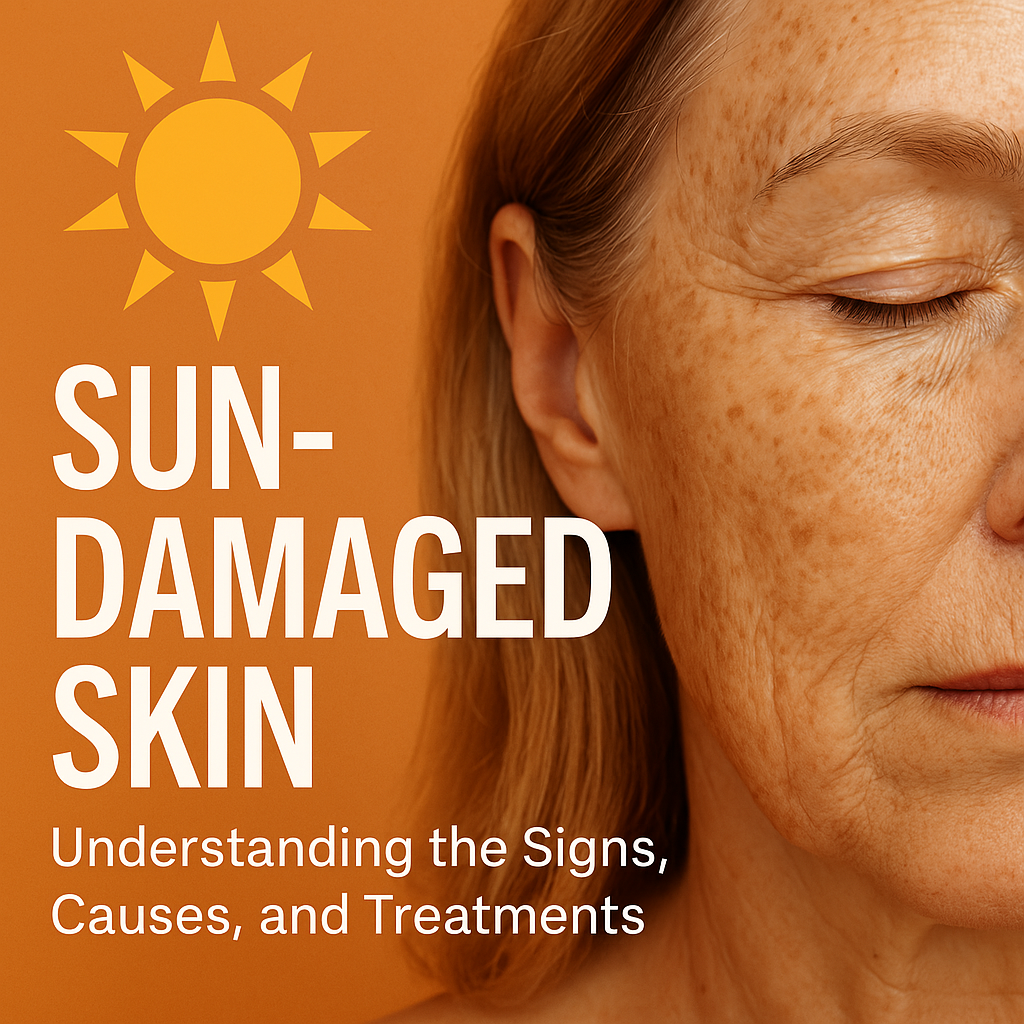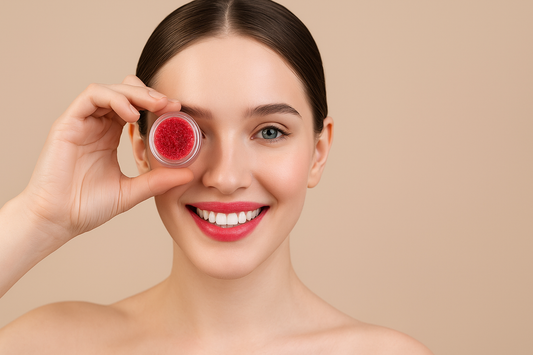
Sun Damaged Skin: Understanding the Signs, Causes, and Treatments
Share
I. Introduction to Sun Damage


A. Definition of Sun-Damaged Skin
Sun-damaged skin refers to the various changes that occur in the skin due to prolonged exposure to the sun’s harmful ultraviolet (UV) radiation. This type of damage can manifest as discoloration, wrinkles, and a rougher texture, affecting the skin's overall appearance and health.
B. Importance of Understanding Sun Damage
Understanding sun damage is crucial for prevention and effective treatment. Recognizing the signs early can help individuals take proactive steps to avoid more significant issues like advanced aging and skin cancers.
C. Overview of Ultraviolet (UV) Radiation


UV radiation is divided into two primary types: UVA and UVB. UVA rays penetrate deeply into the skin, contributing to premature aging and wrinkles, while UVB rays are responsible for sunburn and play a crucial role in developing skin cancer. Awareness of how these rays affect the skin is the first step towards protection.
II. Signs of Sun-Damaged Skin
A. Common Visible Changes
- Discoloration and Sunspots: One of the earliest signs of sun damage is the appearance of sunspots or age spots, which are flat, brownish spots on the skin.
- Increased Fine Lines and Wrinkles: Over time, sun exposure can lead to a decrease in collagen production, resulting in fine lines and wrinkles, especially around the eyes and mouth.
- Texture Changes: Rough and Dry Skin: Sun-damaged skin can become rough and dry, losing its natural moisture and softness.
B. Less Obvious Symptoms
- Capillary Damage: Sometimes, tiny blood vessels can become damaged, leading to redness and spider veins.
- Reduced Elasticity: As we age, the damage from sun exposure can cause the skin to lose elasticity, leading to sagging.
- Chronic Dryness: The skin may become persistently dry and flaky due to sun-induced damage to its barrier function.
C. Progression of Symptoms


- Early Signs vs. Advanced Damage: Initial signs like sunspots and fine lines can evolve into deep wrinkling and significant discoloration if left untreated.
- Potential for Skin Cancers: Prolonged and severe sun damage can increase the risk of various forms of skin cancer, making regular check-ups essential.
- Psychological Impact: Beyond physical changes, the visible effects of sun damage can also lead to feelings of self-consciousness and lower self-esteem.
III. Causes of Sun Damage
A. Role of UV Radiation
- UVA vs. UVB Rays: As mentioned earlier, UVA and UVB rays each have different effects on the skin. Knowing the difference allows for better protective measures.
- How UV Exposure Accumulates: Even brief, casual exposure adds up over time. That’s why it’s essential to protect your skin even on cloudy days or while driving.
- Reflection and Refraction of UV Rays: UV rays can reflect off surfaces like water and sand, increasing exposure—even if you think you’re in the shade!
B. Skin Types and Vulnerability
- Understanding Skin Types (Fitzpatrick Scale): This scale ranks skin types based on how they react to UV light, where lighter skin is generally more susceptible to damage.
- Genetic Factors: Some people inherit skin that is more prone to damage and burning, making it vital for them to be especially vigilant.
- Age and Sun Sensitivity: With age, the skin’s ability to recover from sun damage diminishes, making older adults more vulnerable.
C. Environmental Factors
- Geographic Location: Living closer to the equator or at higher altitudes usually increases UV exposure levels.
- Seasonal Variations: The intensity of UV radiation varies by season—summer months tend to be more damaging.
- Urban vs. Rural Exposures: While urban areas may offer some protection due to pollution, rural landscapes can expose individuals to intense reflective surfaces like snow and water.
IV. Treatment Options for Sun-Damaged Skin


A. At-Home Remedies
- Moisturizers and Hydration: Keeping the skin hydrated can improve its texture and appearance while minimizing the effects of sun damage.
- Natural Treatments (Aloe Vera, Vitamin E): Both are renowned for their soothing properties; using these can help repair skin and reduce inflammation.
- Sunscreens: Choosing the Right SPF: Using a broad-spectrum sunscreen daily is essential for protecting against further damage. Look for SPF 30 or higher.
B. Professional Treatments
- Topical Prescription Treatments (Retinoids, Hydroquinone): These can help accelerate skin renewal and reduce pigmentation.
- Cosmetic Procedures (Chemical Peels, Microdermabrasion): These methods exfoliate the top layer of skin, revealing fresher skin beneath.
- Advanced Therapies (Laser Treatments, Phototherapy): Professional treatments can help address more severe signs of damage and rejuvenate the skin.
C. Preventive Measures
- Daily Sun Protection Practices: Hat wearing and seeking shade are essential practices in addition to sunscreen use.
- Regular Skin Check-ups: Routine dermatologist visits help catch any changes early.
- Educating Others About Sun Safety: Sharing knowledge with friends and family can build a community of awareness and prevention.
V. Lifestyle Changes to Support Skin Repair
A. Dietary Adjustments
- Foods Rich in Antioxidants: Consuming berries, nuts, and green leafy vegetables can help combat oxidative stress caused by sun exposure.
- Hydration and Skin Health: Drinking plenty of water is key for maintaining skin hydration and health.
- Vitamins and Supplements for Skin Repair: Considering Vitamin C, E, and Omega-3 fatty acids can support skin recovery.
B. Avoiding Harmful Habits
- Smoking and Skin Aging: Smoking can exacerbate sun damage and accelerate aging processes.
- Alcohol Consumption: Excessive drinking can dehydrate the skin, worsening its texture.
- Stress Management Techniques: High stress can affect skin health; mindfulness techniques and relaxation activities enhance overall well-being.
C. Embracing Healthy Practices
- Regular Exercise and Circulation: Physical activity improves blood flow, delivering essential nutrients to the skin.
- Consistent Skincare Routines: Establishing a skincare routine that includes regular exfoliation and moisturization aids in repairing damage.
- Importance of Sleep for Skin Repair: Adequate rest allows the body, including the skin, to recover and regenerate.
VI. Conclusion
A. Summary of Key Points
Understanding sun damage empowers individuals to recognize early signs, know the causes, and explore treatment options.
B. Long-Term Commitment to Skin Health
Regular sun protection and maintenance are necessary for preserving skin health over time.
C. Encouragement to Seek Professional Advice
Don’t hesitate to reach out to a dermatologist for personalized advice that fits your skin type and history.
VII. Frequently Asked Questions (FAQs)
A. How can I tell if my skin is sun-damaged?
Look for signs like discoloration, sunspots, increased wrinkles, or a rough texture.
B. Is sun damage reversible?
While some effects can be improved with treatments, complete reversal isn’t always possible.
C. What type of sunscreen is best for preventing sun damage?
A broad-spectrum sunscreen with SPF 30 or higher is generally recommended.
D. Can sun damage lead to skin cancer?
Yes, prolonged exposure to UV radiation can increase the risk of developing skin cancers.
E. How often should I apply sunscreen when outdoors?
It’s best to reapply every two hours, or more often if swimming or sweating.







